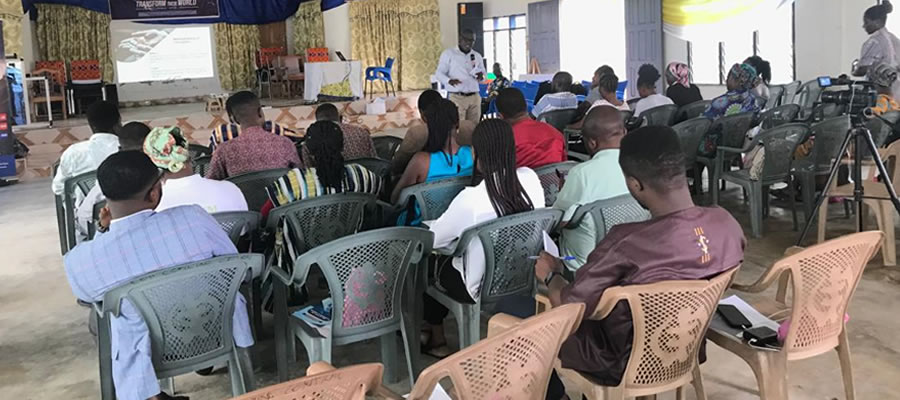

Introduction
Population size, composition and age-sex structures are critical in understanding the fertility, mortality and migration dynamics of any country. Population composition is the description of a population according to characteristics such as age, sex, marital status, ethnicity, education and occupation (2010 PHC National Analytical Report). This chapter provides information about the characteristics of the population of the Ayensuano District from the 2010 PHC. It describes the population size and distribution in the rural and urban areas, age and sex structure, dependency ratio, fertility, mortality and migration in the area.
Population Size and Distribution
Table 2.1 shows the distribution of the population size for both sexes (male, female) and by their locality of residence (urban, rural) and sex ratio. The total population for the District is 77,193. This is constituted by 38,440(49.8%) males and 38,753(50.2%) females. From Table 2.1, the majority of the District’s population lives in the rural areas (93%) while only a proportion of the population reside in the urban areas (7%). It can also be observed from Table 2.1 that the sex ratio is higher for the age group 0-19 years.
Age- Sex Structure
Table 2.2 illustrates the age structure by sex, distribution and age group in the District. Majority of the District’s population fall below 15 years (40.5%), 15-24 years (16.4) and 30-59 years (27.3%) age groups. There are disparities across the different age groups for both males and females. From Table 2.2, the under 15(42.3%) and 15-24 years (16.9) age groups show higher proportion of males than females. But the proportion of females from the age group 25-29 (7.2%), 30-59 (28.4%) and 60+ years (9.8%) are higher than that of males.
Table 2.3 shows the age structure by sex for the District. It can be seen from Table 2.3 that the District’s population is highly concentrated at ages 0-4 (15%), 5-9 (13.3%) and 10-14 (12.1%). This implies that comparatively the District has a wider youthful base, hence the greater the dependency load on the older age groups. The distribution of males (42.1%) is higher than females (38.6%) among these age groups.
However, the age groups 80-84 (0.8%) and 85+ (0.9%) recorded less than one percent each of the district’s population.
Figure 2.1 shows the population pyramid of the Ayensuano District. A population pyramid graphically portrays the age and sex structure of a population. There is high concentration of population at the ages 0-24 years (57%) which gives it a broad base. This means that the District has a youthful population. The shape of the pyramid gradually reduces as the concentration of the population decreases as age increases.
The population pyramid shows that there are fewer females than males at ages 0-19 years. However, from ages 20 years and above, females tend to be more than their male counterparts though the increase is marginal
Age Dependency Ratio
Dependency ratio is a measure of the dependent population made up of those below 15 years and 65 years and older, to those in the “economically productive” ages of 15-64 years.
Table 2.4 shows the age dependency ratio by sex. According to the table, the total dependency ratio of the District is 88. This suggests that for every 100 people in the working age population, about 88 people depend on them.
It is evident that child dependency constitutes more than half (76.1) as compared with old age dependency ratio (11.9).
Child dependency ratio among males (81.4) is higher than females (71). This means 100 persons in the working class cater for almost 82 (81.4) male children whiles 100 persons cater for 71 female children. On the other hand, with old age dependency ratio, 100 persons cater for 11 males and almost 13 (12.8) females respectively.
Fertility, Mortality and Migration
Fertility
Fertility rate is the number of children born per couple, individual or population. During the 2010 census, data on fertility is collected on two types; lifetime fertility and current fertility. Lifetime fertility refers to the total number of live births that females 12 years and older have ever had during their life time. Current fertility refers to the number of live births that females 12-54 years old had in the 12 months preceding the Census Night.
Table 2.5 shows data on total fertility rate, general fertility rate and crude birth rate in all Districts in the Eastern Region. The Ayensuano District has a total fertility rate of 4.2, general fertility rate (126.2) and crude birth rate of 28.1 which are higher than the regional figures of 3.5, 103.9 and 25.4 respectively.
Children ever born
To know the number of births among women, data is collected on the number of life births and those who survived after birth in the past 12 months prior to the census. This data is gathered for women aged 12 years and older.
Table 2.6 shows that the total number of children ever born by females in the District is 85,061 which comprise 42,766 (50.3%) males and 42,295 females (49.7%).
On the average, approximately 3.2 children have ever been born by women aged 12 to 60 years and above. The age group 12-14 years (0.0%) has the least life births for both sexes while 60+ (6.3) have the highest. 21
Children surviving
Table 2.6 further presents data on children surviving by sex of the child. Of 85,061 children ever born, 71,998 survived. On the average, 2.7 of children ever born survived.
Mortality
Mortality refers to all deaths that occurred in the household during the 12 months preceding the Census Night.
Table 2.7 presents data on the total population, household deaths and crude death rates in all Districts in the Eastern Region. The total population of the Ayensuano District is 77,193 and out of this, there are 741 household deaths and 9.6 crude death rate within the last 12 months preceding the Census.
Table 2.5 shows that the crude death rate in the Ayensuano District is 9.6 which are higher than the regional rate of 8.2. This means that on the average, the Ayensuano District records almost 10 deaths per 1,000 live births while at the regional level it is almost nine deaths per 1000 live births. However, the District is among the districts with the least household deaths of 741 (3.4%).
Age specific death rates (ASDRs)
Death rates are calculated for specific age groups in order to compare mortality at different ages or at the same age over time. The Age Specific Death Rates (ASDRs) are computed as a ratio of deaths of people in a specified age group, for example the ASDR of 20-24 year-age is calculated by taking the deaths among the 20-24 year-age group and dividing it by the population in that age group (20-24 years), multiplied by 1,000.
Figure 2.2 provide information on age specific death rates. The data show that death rates for males and females are higher in ages under five years but lowest at ages 5-14 years. The death rates start rising at ages 15-19 with more females than males and intensifies with increase in age until 40-44 years. Between ages 15-34 (the reproductive period), ASDRs for females are higher than males and this may be attributed to maternal mortality. ASDRs for males are higher at ages 50 years and older than females and this is an indication of a lower life expectancy for males compared to females. Additionally, at ages 50 years and older, differences between male and female ASDRs are very high compared with the lower age groups.
Migration
According to the 2010 PHC, migration of the population is measured by the data on the place of birth with place of enumeration and duration of stay at the place of enumeration. This data is collected to help analyse the internal and inter-regional movements of people in the District.
Birthplace by duration of residence of migrants
The birthplace by duration of residence of migrants in the District is presented in Table 2.8. Out of the total population of the district, 17,193 (66.5%) are born elsewhere in the same region, 8, 005 (31%) are born elsewhere in another region and 633 (2.5%) outside Ghana, this suggests that the District’s population is diverse in relation to locality or context.
Table 2.8 shows that almost 51 percent (50.6%) of persons who have stayed between 1-4 years are born in Upper East Region. The least percentage of the population in the District who have stayed for 5-9 years, are born in Upper West Region (2%). For the duration of stay, 10-19 years (19.4%) and 20 years and above (32.7%), the majority of persons enumerated are born in Volta Region.
Date Created : 11/23/2017 8:02:44 AM











 facebook
facebook
 twitter
twitter
 Youtube
Youtube
 +233 593 831 280
+233 593 831 280 0800 430 430
0800 430 430 GPS: GE-231-4383
GPS: GE-231-4383 info@ghanadistricts.com
info@ghanadistricts.com Box GP1044, Accra, Ghana
Box GP1044, Accra, Ghana